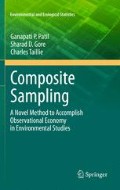Abstract
The foregoing chapters covered various issues involving composite sample data with their statistical treatment. The problems vary from classification of individual samples to drawing inference on population parameters, especially the population mean. The measurements can be either presence/absence or continuous. A common theme in all these chapters is the need to establish a relationship between individual sample values and composite sample values.
*Deceased
Access this chapter
Tax calculation will be finalised at checkout
Purchases are for personal use only
Bibliography
Bohrnstedt, G. W. and Goldberger, A. S. (1969). On the exact covariance of products of random variables. J. Am. Stat. Assoc. 64:1439–1443.
Brown, G. H. and Fisher, N. I. (1972). Subsampling a mixture of sampled material. Technometrics 14:663–668.
Cameron, J. M. (1951). The use of components of variance in preparing schedules for sampling of baled wool. Biometrics 7:83–96.
Elder, R. S. (1977). Properties of composite sampling procedures. Ph.D. Dissertation. Virginia Polytechnic Institute and State University, Blacksburg, VA.
Elder, R. S., Thompson, W. O., and Myers, R. H. (1980). Properties of composite sampling procedures. Technometrics 22:179–186.
Graham, A. (1981). Kronecker Products and Matrix Calculus: with Applications. Ellis Horwood, Chichester.
Orban, J. E., Lordo, R., and Schwemberger, J. (1990). Statistical methods for analyzing composite sample data applied to EPA’s human monitoring program. MS.
Rohde, C. A. (1976). Composite sampling. Biometrics 32:273–282.
Skinner, C. J., Holt, D., and Smith, T. M. F. (1989). Analysis of Complex Surveys. Wiley, New York, NY.
Author information
Authors and Affiliations
Corresponding author
Rights and permissions
Copyright information
© 2011 Springer Science+Business Media, LLC
About this chapter
Cite this chapter
Patil, G.P., Gore, S.D., Taillie*, C. (2011). A Linear Model for Estimation with Composite Sample Data. In: Composite Sampling. Environmental and Ecological Statistics, vol 4. Springer, Boston, MA. https://doi.org/10.1007/978-1-4419-7628-4_8
Download citation
DOI: https://doi.org/10.1007/978-1-4419-7628-4_8
Published:
Publisher Name: Springer, Boston, MA
Print ISBN: 978-1-4419-7627-7
Online ISBN: 978-1-4419-7628-4
eBook Packages: Earth and Environmental ScienceEarth and Environmental Science (R0)

